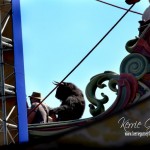This article contains some Story Spoilers, so be wary. Since late June, a new set of yellow “location pointers” have appeared on major intersections in West Auckland, New Zealand. It’s a sure sign that filming is in progress somewhere not too far away, and every morning cast and crew for the project will be homing into that location from wherever they live. These particular pointers are marked “LPP” for “Lamp Post Productions.” If you’ve ever read The Lion, the Witch, and The Wardrobe, you might remember a particular lamp-post which is in Narnia. Sure enough, filming for The Lion, the Witch, and The Wardrobe is in full swing and hundreds of people are converging on this very ordinary corner of the world to create another world which is much more enchanting.
Part of the magic of film – of even the most magical of fantasy films – is the fact that the surroundings can be so un-magical. The Lord of the Rings introduced moviegoers to New Zealand, and it’s true that it did star some locations that were dramatic enough to be called “magical” – stunning mountains, wild forests, strange rocky steppes. But West Auckland, the home of the Narnia films, sits in surroundings that can only be described as “pleasant.” There are nice green fields, little stands of trees, and small hills that can serve for just about any kind of rural backdrop. They’ve appeared in Xena, Hercules, and countless small movies and ads. But so far they aren’t featuring much in The Lion, the Witch, and The Wardrobe. A good deal of the principal photography has taken place in the big sound stages that have been created in some disused apple packing sheds in a run-down industrial area of West Auckland.
Once inside the shabby-looking security fence and dull parking lot, it’s a different story. Hundreds of people are working in a state of calm frenzy at tasks that range from the very large – visualise crews of guys with nail guns and blowtorches who engineer and build the big sets – to the very small, such as the people who hover alertly on the set with a holster-style kit of puffers and brushes for adjusting make-up on the actors.
It’s 1pm on a typical workday on the LWW set, and I’m being given a tour of a bewildering place where past, present and future sets are elbowing for space. Some are just a heap of plywood and styrofoam dusted with fake snow – no telling what they were once. Some are only in 3D sketch form – such as the sound stage they are building which is a hall or courtyard with tall shard-like pillars of ice or icy stone. Maybe it’s the hall Edmund passes through in the Witch’s House: “He found himself in a long gloomy hall with many pillars, full, as the courtyard had been, of statues.” And indeed, just outside that sound stage I saw a great grey statue of a centaur magically petrified. It reared up, frozen in the middle of some struggle, but for now wanting storage space.
But three soundstages are busy today. The first is the Beaver’s house. It’s a set “in the round,” – the camera can move through 360 degree inside it. It’s cosy, with an oval, domed form, comfortable if a little cramped. The inside and outside look convincingly beaver-built out of mud and waterbleached sticks. As I watch, a crew adjusts a paper lantern that hangs in the middle of it. The same sound stage has a litter of fascinating props – a stuffed wolf on a stand, a rack of fur coats, and best of all, the magical Wardrobe itself. It looks like a beautiful antique – reddish wood polished to a high gloss. The door is richly carved with a tree – maybe a nod to Lord of the Rings fans here, because the tree has a similar style to the White Tree of Gondor. The Wardrobe is huge – easily big enough for an adult to get into – but not so big as to be ridiculous. The rack of fur coats stands nearby, and perhaps in the film Lucy will feel her way through them to the back of the wardrobe – which isn’t there. I was told that the camera will look through the wardrobe to a bluesceen where I assume Lucy will get her first glimpse of Narnia, and so will we.
I had a look at another set, built mostly of translucent fibreglass, which is the White Witch’s dungeon. It looks entirely made of ice, with rusty, spiky iron grills covering the openings. The ice appeared to have grown over the architecture so that the doors or windows had an organic kind of shape, rounded and glassy, rather than the clean lines of stone architecture. It reminded me of the creepy, inhuman forms that featured to such effect in Alien . I heard of what seems to be a departure from the book, in that Edmund is imprisoned here and must be rescued by the others at some point. Edmund’s imprisonment was obviously not happy, judging from the muffled shouting I could hear from within.
The third set I visited was all action, and this is where the rest of the Pevensie children were escaping from danger. They’d already met Father Christmas, and were carrying his gifts. In the book, their journey from then on is “a delicious dream,” for Spring overtakes the woods of Narnia in a matter of hours. It looks like the movie version will be more dramatic, with the Witch’s pursuit hounding them much more closely.
In the scene I watched, wolves were chasing them across the ice, while above them a towering, icicle-hung cliff threatened to collapse its weight of snow on them. The White Witch’s endless winter was wearing off, and the sudden thaw was creating some problems for the children. As they ran across the set they came under the first barrage of what could be an avalanche from the cliff above. Worse, the ice under their feet was breaking up. (For this, the set builders had made a clever series of “lily pads” of ice which dipped alarmingly on hydraulic supports as the children started to run across. Water squirted up – not always where expected, and there was some laughter in the crew from that!)
In the finished film, the children will be accompanied here by the Beavers. The Beavers are entirely done by CGI, and so for the purposes of shooting, a guy on the set called out Mr. Beaver’s lines while a small brown sock puppet on a boom bobbed ahead of the children so they could see where the Beaver would be. Meanwhile, somebody else had the job of doing the wolf-howls that pursued the children and lent urgency to their flight. The camera focussed on Lucy, whose expression reflected her terror at the wolves behind her and her fear of the treacherous ice underfoot. I watched the scene on the monitor. Lucy was plucky, but hesitant. The older children knew they mustn’t stop, and pulled her along with them. Peter took on the risk of finding a safe way across the ice. Susan brought up the rear, guarding and encouraging Lucy. It could be a snapshot of the relationship between the children.
Something about all this is, of course, completely ridiculous. Imaginary wolves, grown men doing wolf imitations, sock puppets on sticks. But on the other hand there is something wonderful about watching a group of children throwing themselves totally into the kind of make-believe that we all did at some time in our lives. What child hasn’t whiled away a rainy afternoon with their friends playing “Let’s Pretend”? “Let’s pretend some bad guys are after us and you hit them with your sword.” “Let’s pretend we’re being chased by wolves.” Most of us loved playing those games, and did it until we had to stop and grow out of it. It’s somehow satisfying to see that old and simple game of make-believe taken to its ultimate form, being used to make something that will one day be as realistic and exciting as we always wished our games to be.


